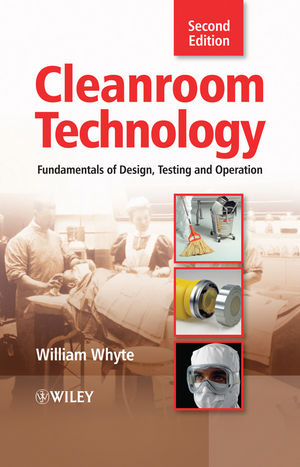Cleanroom Technology: Fundamentals of Design, Testing and Operation, 2nd EditionISBN: 978-0-470-74806-0
Hardcover
384 pages
March 2010
 This is a Print-on-Demand title. It will be printed specifically to fill your order. Please allow an additional 15-20 days delivery time. The book is not returnable.
|
||||||
Preface.
Acknowledgements.
1 Introduction.
1.1 What is a Cleanroom?
1.2 The Need for Cleanrooms.
1.3 Types of Cleanrooms.
1.4 What is Cleanroom Technology?
2 The History of Cleanrooms.
2.1 The Earliest Years.
2.2 Ventilated Operating Rooms.
2.3 Early Industrial Cleanrooms.
2.4 Unidirectional Airflow Cleanrooms.
3 Cleanroom Classification Standards.
3.1 The History of Standards.
3.2 The Basis of Cleanroom Standards.
3.3 Federal Standard 209.
3.4 ISO Standard 14644-1:1999.
3.5 Pharmaceutical Cleanroom Classification.
3.6 Classification of Cleanrooms with Airborne Chemical Contamination.
3.7 Classification of Cleanrooms with Surface Contamination.
4 Information Sources.
4.1 The International Confederation of Contamination Control Societies (ICCCS).
4.2 The ICEB.
4.3 International Cleanroom Standards.
4.4 Cleanroom Books.
4.5 Recommended Practices and Guides of the Institute of Environmental Sciences and Technology (IEST).
4.6 Cleanroom Journals and Magazines.
4.7 Sources of Pharmaceutical Cleanroom Documents.
4.8 Training Videos/DVDs.
5 Non-unidirectional Airflow and Ancillary Cleanrooms.
5.1 Non-unidirectional Airflow Cleanrooms.
5.2 Ancillary Cleanrooms.
6 Unidirectional Airflow Cleanrooms.
6.1 Types of Unidirectional Cleanrooms.
6.2 Vertical Unidirectional Airflow Cleanrooms.
6.3 Horizontal Unidirectional Airflow Rooms.
6.4 The Application of Unidirectional Airflow.
7 Separative Clean Air Devices and Containment Zones.
7.1 Unidirectional Airflow Devices.
7.2 Mini-environments, Isolators and RABS.
7.3 Containment Zones.
8 Construction and Clean-build.
8.1 Constructional Materials and Methods.
8.2 Outgassing and Electrostatic Properties.
8.3 Clean-build.
9 High Efficiency Air Filtration.
9.1 Air Filters Used in Cleanrooms.
9.2 The Construction of High Efficiency Filters.
9.3 Particle Removal Mechanisms.
9.4 Testing of High Efficiency Filters.
9.5 Scan Testing of High Efficiency Filters.
9.6 Filter Housings for High Efficiency Filters.
9.7 Removal of Airborne Chemical Contamination.
10 Cleanroom Testing and Monitoring.
10.1 Principles of Cleanroom Testing.
10.2 Cleanroom Tests.
10.3 Testing in Relation to Room Type and Occupation State.
10.4 Re-testing to Demonstrate Compliance.
10.5 Monitoring of Cleanrooms.
11 Measurement of Air Quantities and Pressure Differences.
11.1 Air Quantities.
11.2 Differential Pressure Tests.
12 Air Movement Control: Containment, Visualization and Recovery.
12.1 Cleanroom Containment Leak Testing.
12.2 Air Movement Control within a Cleanroom.
12.3 Recovery Test Methods.
12.4 Recovery Rate Requirement in the EU GGMP.
13 Filter Installation Leak Testing.
13.1 The Use of Aerosol Test Challenges.
13.2 Artificial Aerosol Test Challenges.
13.3 Apparatus for Measuring Aerosol Penetration.
13.4 Methods of Testing Filters and Filter Housings.
13.5 Repair of Leaks.
14 Airborne Particle Counts.
14.1 Airborne Particle Counters.
14.2 Continuous Monitoring Apparatus for Airborne Particles.
14.3 Particle Counting in Different Occupancy States.
14.4 Measurement of Particle Concentrations.
14.5 Worked Example of ISO 14644-1 Test Method.
15 Microbial Sampling.
15.1 Microbial Sampling of the Air.
15.2 Microbial Deposition onto Surfaces.
15.3 Microbial Surface Sampling.
15.4 Personnel Sampling.
16 Operating a Cleanroom: Managing the Risk from Contamination.
16.1 Step 1: Identification of Sources and Routes of Contamination.
16.2 Step 2: Risk Assessment and the Control of Sources of Contamination.
16.3 Step 3: Establish an Effective Monitoring Programme.
16.4 Step 4: Verification and Reappraisal of the System.
16.5 Step 5: Documentation.
16.6 Step 6: Staff Training.
17 Cleanroom Disciplines.
17.1 People Allowed into Cleanrooms.
17.2 Personal Items Not Allowed into the Cleanroom.
17.3 Disciplines within the Cleanroom.
17.4 Maintenance and Service Personnel.
18 Entry and Exit of Personnel.
18.1 Prior to Arriving at the Cleanroom.
18.2 Changing into Cleanroom Garments.
18.3 Exit Changing Procedures.
19 Materials, Equipment and Machinery.
19.1 Choice of Materials for use in a Cleanroom.
19.2 Items Supplied from Outside Manufacturing Sources.
19.3 Wrapping and Transportation of Materials.
19.4 Transfer of Items and Small Pieces of Equipment through a Material Transfer Airlock.
19.5 Entry of Heavy Machinery and Bulky Items.
19.6 Transfer of Materials through Hatches and Sterilisers.
20 Cleanroom Clothing.
20.1 Sources and Routes of Inert Airborne Particle Dispersion.
20.2 Routes and Sources of Microbial Dispersion.
20.3 Types of Cleanroom Clothing.
20.4 Processing of Cleanroom Garments and Change Frequency.
20.5 The Effect of Laundering and Wear.
20.6 Testing of Cleanroom Clothing.
20.7 Static Dissipative Properties of Clothing.
21 Cleanroom Masks and Gloves.
21.1 Cleanroom Masks.
21.2 Cleanroom Gloves.
22 Cleaning a Cleanroom.
22.1 Why a Cleanroom must be Cleaned.
22.2 Cleaning Methods and the Physics of Cleaning Surfaces.
22.3 Implements Used to Clean Cleanrooms.
22.4 Liquids Used in Cleaning Cleanrooms.
22.5 How Should a Cleanroom be Cleaned?
22.6 Cleaning Programme.
22.7 Test Methods.
Index.



